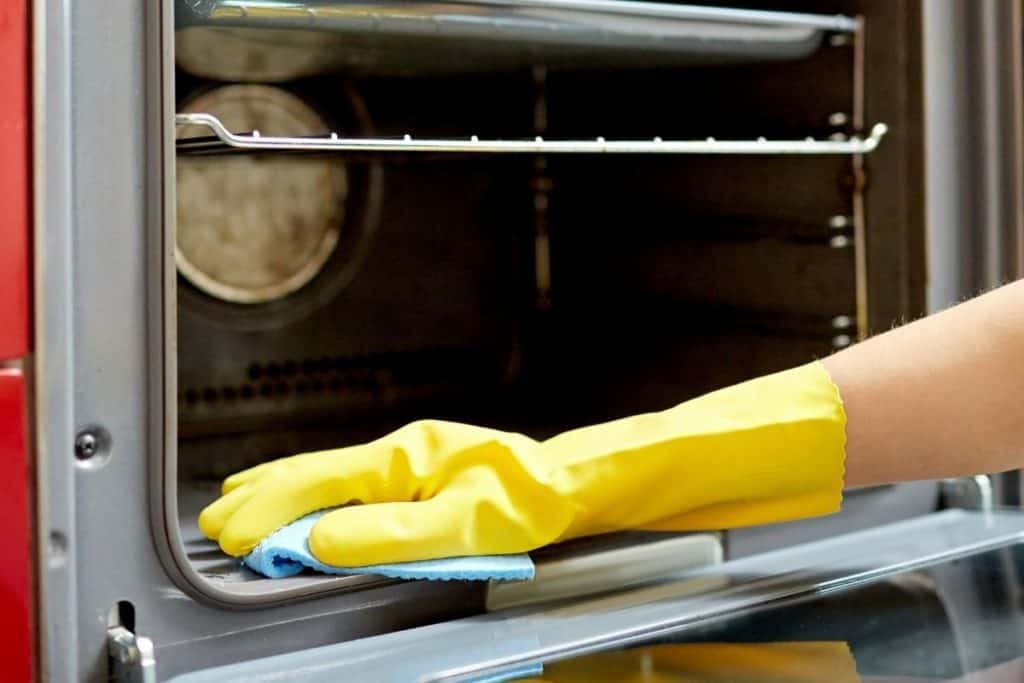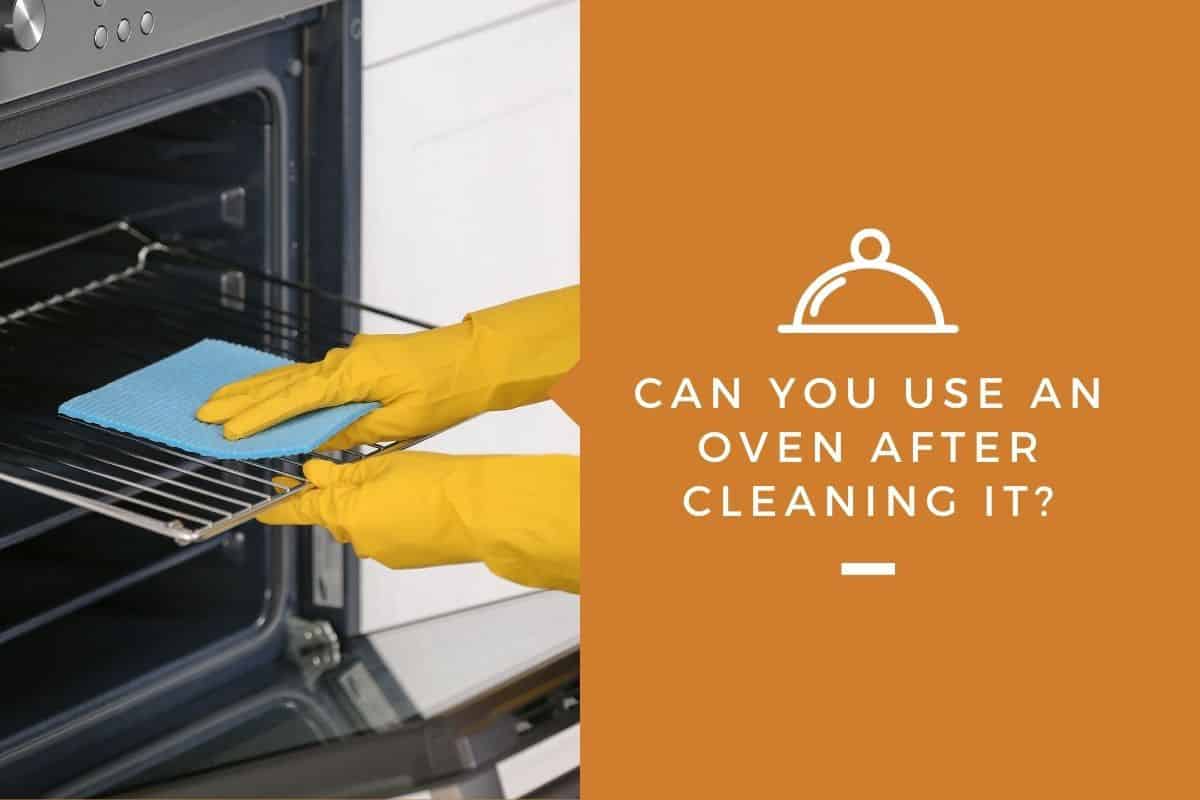Keeping a kitchen appliance clean is vital for both our health and the device’s lifespan. The appliances we use for cooking are exposed to grease and grime, which will build up quickly as the appliance is used. To counteract the build-up the oven must be cleaned, sometimes with products containing chemicals.
Some ovens have self-cleaning cycles while others are supposed to be cleaned manually, using cleaning products and a damp cloth.
Now that you’ve contaminated your oven with cleaning sprays, will it really be safe to use? That’s the most common question I get after guiding someone through the process of cleaning an oven.
When cleaning an oven with cleaning products containing chemicals such as Sodium Hydroxide or Amphoteric Surfactants it’s recommended to let the oven run at maximum temperature for 15 to 30 minutes and wipe it clean before using it. During this time the oven can emit smoke, as the chemicals are burnt off.
If you instead choose to clean your oven with a natural solution of vinegar and baking soda, then the oven can be used right away.
Keep in mind that the toxin-free solution is, as expected, less effective than the products packed with chemicals but it will still get the job done, it may just take a little while longer.
These two different methods work very well, and depending on which one you choose, there are a couple of things to keep in mind.
How Do I Make Sure My Oven is Safe to Cook in After Cleaning?
As mentioned above, the first step is to run the oven at max temperature for 15 to 30 minutes. The chemicals will produce smoke as they’re burning up, this can also emit a strange smell.
The oven should stop emitting smoke within several minutes if you haven’t forgotten to clean out the chemical residue.
Smoke or no smoke, the oven should still continue to burn away at max temperature for about half an hour. Products that are specifically made for oven-cleaning will state how long you should wait before using the oven, but a good portion of them don’t provide any information on the topic.
Burning-in the oven and ventilating it should be part of your routine when using chemicals products to be on the safe side.
The chemicals in these products will cause irritation to the skin and eyes if they’re exposed to it during cleaning. I highly doubt you would want to take it a step further and marinate your food in a product with those side-effects.
While I use these products on a regular basis, and with great results, I’m always on the safe side of things. With that said, I do use natural solutions as well – these natural solutions will have the oven up and running as soon as you’ve finished cleaning it.
They’re free from hazardous chemicals, which leaves you with nothing to worry about.
Creating a paste consisting of vinegar and baking soda is one of the most common ways of naturally cleaning your oven.
How Long After Running a Self-Cleaning Cycle in an Oven Can I Cook in it?
Ovens with a self-cleaning system will run at high temperatures to burn away all the grime in the oven. Depending on which model you have, a self-cleaning cycle can last anywhere from 30 minutes to several hours.
During this time, the oven door is locked and will remain locked until the oven has finished the cycle and cooled down.
The self-cleaning process will turn the grime and grease into white ashes, which you will see once you’re able to open the oven chamber. Remove the ashes using a damp cloth dipped in water and vinegar. The oven is safe to use as soon as you’ve removed all of the ashes.
The self-cleaning cycle can (it will) cause the oven to reach incredibly high temperatures. These temperatures can produce fumes which have proven to have a negative effect on human beings.
When running a self-cleaning cycle, make sure you open your windows to provide proper ventilation. This should minimize the build-up of carbon monoxide in your home.
Your oven will notify you when the self-cleaning cycle is complete. Well, the models I’ve seen have some way of notifying that the cycle is complete. Regardless, as soon as the oven door can be opened, feel free to use the oven without caution.
Is Oven Cleaner Residue Dangerous?

There’s a good portion of oven cleaners on the market that contain strong chemicals. One of the most common chemicals found in oven cleaners is sodium hydroxide, also known as caustic soda. Sodium hydroxide is the perfect chemical for an oven cleaner because of its ability to remove fats. It’s also frequently used to clean drains, which often contain grease as well.
Using these oven cleaners can be far from safe if you don’t do it with caution. Most strong chemicals tend to irritate the skin and eyes, and sodium hydroxide is no exception to the rule.
In fact, when using strong oven cleaners you should make sure to wear safety goggles and gloves to protect your skin and your eyes. Handling strong chemicals is no joke. Some reports have shown that sodium hydroxide is corrosive enough to cause skin burns, respiratory problems, and hair loss.
When you run the oven, most of the bad stuff in these products will turn to vapor and disappear or float away but remember to always follow the instructions on the can.
These products have been designed to reduce the amount of time spent removing grease from kitchen appliances. Thankfully, these products come with directions on how to use them to minimize the risks. Read them and follow them.
Will Oven Cleaner Residue Burn Off?
Ovens have a bunch of crevices and nooks where oven cleaner can end up and be forgotten. Will it burn off? The truth is that a good portion of the oven cleaner will burn off and evaporate when you run the oven at max temperature, producing fumes that you should avoiding inhaling.
However, there’s always the possibility that some of the product remains in the oven even after running it. That’s why I recommend wiping the oven clean with a damp cloth to remove all chemical residue.
The residue and white ash that’s left after cleaning the oven can cover all parts of the oven’s inside and once they’re wiped off the oven will regain its luster.
How Often Should You Clean Your Oven?
Cleaning the oven will not only make it cleaner and more hygienic but also make it more efficient. The more grime in the oven, the more likely the oven is to malfunction and stop working as intended.
It can be harder for the oven to reach temperatures as efficiently and the thermometer can stop working as it’s covered in grease, which makes it unable for the thermometer to sense temperatures and regulate them.
Burnt food that’s left unattended in an oven can also impact the taste of other dishes cooked in the oven and while high temperatures will remove most of the bacteria, a dirty oven isn’t the best place to cook food in.
Depending on how and how frequently the oven is used, experts recommend that you should clean it properly every 3-6 months.
The longer you wait the harder it will be to remove the grime that’s collected in the oven. Performing maintenance on the oven on a regular basis will make it so much easier to clean as the grease hasn’t had enough time to burn and harden.
While you aren’t expected to clean the oven thoroughly that often, it’s still recommended that you wipe it down once a month using a rag and hot water. This takes no more than 5 minutes and should be done on both the inside and outside of the oven.
How Long Should I Leave Oven Cleaner On?
When given the chance to work their magic, the strong chemicals in these products will make it very easy to remove the grime from your oven’s inside. Under the right circumstances, you should be able to simply wipe the grime from the oven with very little effort. In order to make this work, the oven cleaner must have had enough time to break down the grease.
Oven cleaner should be applied in a cold oven and then sit for at least a few hours but preferably more. Some users tend to leave their oven cleaner on overnight with great success. The corrosive properties of the chemicals will make sure to penetrate the grime and cause it to loosen from the oven’s walls, racks, and bottom.
If you encounter tough spots that just don’t come off after the first cycle, I would reapply oven cleaner on those tough spots and let it sit for a little while longer before wiping the grime off again. This should do the trick.

